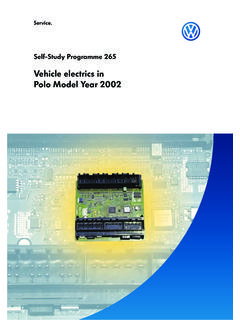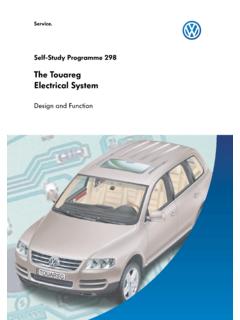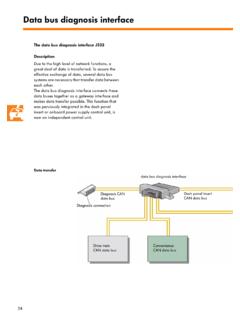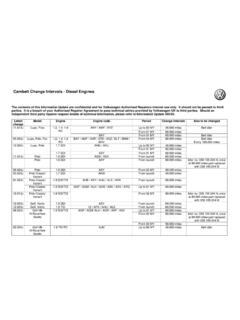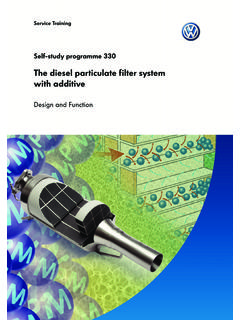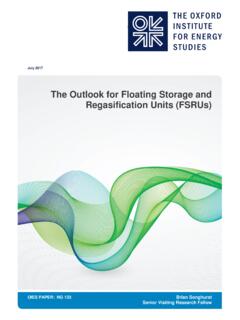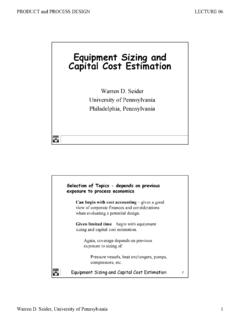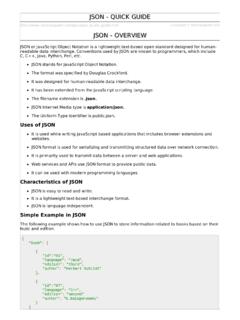Transcription of SSP 316 - The 2.0 ltr. TDI engine - VolksPage.Net
1 Service Training Self-study programme 316. The ltr. TDI engine Design and function The days of sluggish and noisy diesel engines In order to meet the stricter emissions regulations that, when started, startled the whole neighbour- and to further reduce fuel consumption with hood out of bed and left a trail of black smoke greater power output, Volkswagen uses the TDI. when full throttle was applied are long gone. engine generation with 4 valve technology. Driving performance, driving dynamics, driving The ltr. TDI engine was developed as the first comfort, economy and emissions have been four cylinder diesel engine with four valve markedly improved due to the consistent further technology in the Volkswagen Group for use in development of all the engine components, the the Touran, in the Golf 2004 and also in other combustion procedure, the materials and vehicles yet to be introduced.
2 Processes and also the injection pressures. S316_039. NEW Important Note This self-study programme shows the design and For current inspection, adjustment and repair function of new developments! instructions, please refer to the relevant service The contents will not be updated. literature. 2. Contents Introduction ..4. engine mechanics ..6. engine management.. 20. Functional diagram ..38. Service .. 40. Test yourself .. 41. 3. Introduction The kW TDI engine with 4-valve technology S316_011. The kW TDI engine is the first in a line The new kW TDI engine features a of new TDI engine generations with 4 valve newly developed cross-flow aluminium cylinder technology from VOLKSWAGEN.
3 Head with two inlet and two exhaust valves per A 100 kW version of the engine has already cylinder. been introduced in the Volkswagen Touran. Further technical highlights are a switchable It is a further development of the kW cooler for exhaust gas recirculation, a crankshaft TDI engine . The increase in engine size sealing flange with integrated engine speed compared with the standard engine was sender wheel and a new preglow system. achieved by resizing the bore. 4. Technical data engine code BKD. Type 4-cylinder in-line engine Displacement 1968 cm3. Bore 81 mm Stroke mm Valves per cylinder 4. Compression ratio 18:1.
4 Max. output 103 kW at 4000 rpm Max. torque 320 Nm at 1750 rpm to 2500 rpm engine management EDC 16 with unit injector system Fuel Diesel, at least 49 CN. Exhaust gas treatment Exhaust gas recirculation and oxidising catalytic converter Emissions standard EU4. Torque and power development diagram At an engine speed of between 1750 rpm and 400 100. 2500 rpm, the kW TDI engine 360 90 develops 320 Nm of torque. 320 80 Its maximum output of 103 kW is reached at a speed of 4000 rpm. 280 70. 240 60. 200 50. 160 40. Output (kW). Torque (Nm). 120 30. 80 20. 40 10. 0 0. 1000 2000 3000 4000 5000. engine speed (rpm) S316_012.
5 5. engine mechanics The cylinder head Vertically installed, centrally located Roller rocker arm for unit injector unit injector Inlet camshaft Exhaust camshaft Knock-out spindles Roller rocker arm for valves Exhaust port Inlet port Vertically installed valves S316_013. The cylinder head of the ltr. TDI engine is of In addition to exhaust valve timing, the exhaust the cross-flow type made from aluminium with camshaft is responsible for providing drive to the two inlet and two exhaust valves per cylinder. unit injectors. The valves are installed vertically. In addition to inlet valve timing, the inlet camshaft is responsible for providing drive to the The two overhead camshafts are driven together tandem pump.
6 By a toothed belt. Valve actuation is via roller rocker arms, which are mounted on knock-out spindles. 6. The bearing frame The bearing frame is a compact component, pressure cast from aluminium. It is responsible for the following functions: Mounting of the camshafts Spindle mounting and guide for roller rockers to drive unit injectors Mounting of central connector for power supply S316_014 Mounting of cable channel for unit injectors Lateral support and glow plugs. Spindle mounting of Thanks to the overall design of the bearing inlet camshaft frame, which features five strong lateral supports, not only has rigidity in the cylinder head been achieved but the acoustics of the Cable channel engine have also been markedly improved.
7 S316_098. Spindle mounting of exhaust camshaft Central connector Bearing support for roller rocker spindle Fixture concept "bolt in bolt". The bearing frame is bolted directly in the bolt heads of the cylinder head bolts at both inner Bearing frame rows by means of a "bolt in bolt" bonding concept. This space saving concept of joining bearing Cylinder head frame and cylinder head to the engine block is a prerequisite for the low cylinder clearance. Cylinder head bolt Cylinder block S316_100. 7. engine mechanics The 4 valve technology Each cylinder is allocated two inlet and two The vertically installed, centrally located unit exhaust valves, which are installed vertically.
8 Injectors can be found directly above the central piston crowns. Shape, size and layout of the inlet and exhaust This design positively affects the mixture valves are contributory factors for improved formation. The result is a reduction in fuel volumetric efficiency and better air/fuel mixture consumption and lower exhaust emissions. flow. Inlet ports Exhaust ports S316_023. For optimal flow properties through the inlet and exhaust ports, the valve pattern is rotated by 45 to the longitudinal axis of the engine . Valve pattern rotated by 45 Normal layout of valves Longitudinal axis of engine Exhaust ports Inlet ports S316_020 S316_156.
9 8. Drive for inlet and exhaust valves Both camshafts for control of the inlet and Due to dimensional requirements in component exhaust valves are driven by a toothed belt. assembly, the four roller rocker arms differ in size Valve actuation is via roller rocker arms, which and shape. are mounted on a knock-out spindle. Inlet camshaft Exhaust camshaft Knock-out spindle S316_019. Knock-out spindle Roller rocker arm Exhaust valves S316_033. Inlet valves 9. engine mechanics The roller rocker arms Roller rocker arm These are mounted, to allow freedom of movement, on a knock-out spindle. The valve clearance compensator can be found directly above the valve shaft.
10 feed channel Oil is supplied to the valve clearance compensator from the knock-out spindle via a feed channel in the roller rocker arm. A floating glide element installed between valve clearance compensator and valve shaft, ensures an equal and balanced distribution of force. Valve clearance compensator Glide element Knock-out spindle Valve shaft S316_021. Design and function of valve clearance compensator The valve clearance compensator comprises, Camshaft among other things, of two parts: Cylinder Plunger and cylinder. These are subjected to opposing forces. Plunger A plunger spring forces both parts apart so that the clearance is taken up between roller rocker Non-return valve arm and camshaft.
